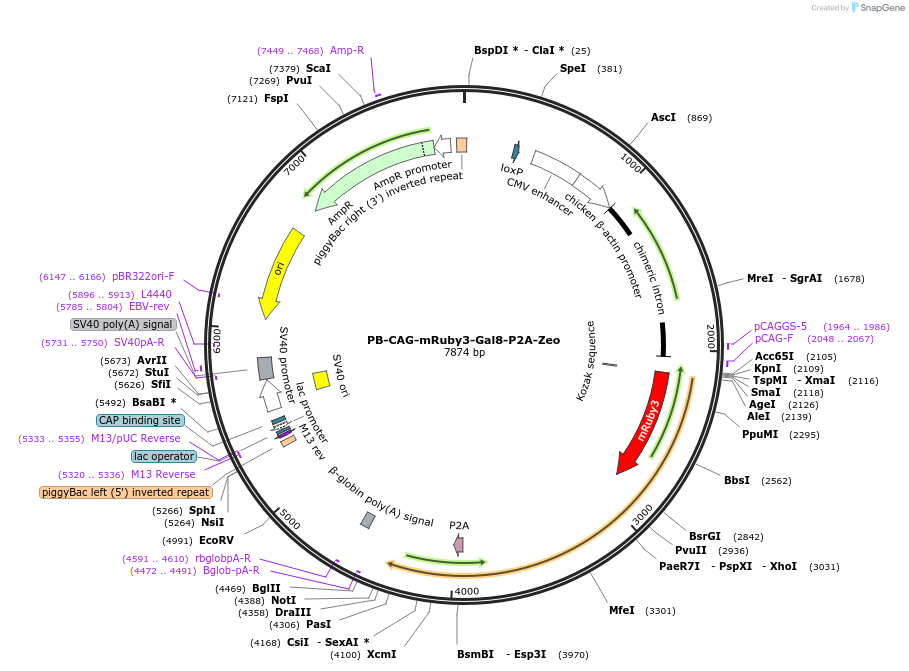-
PurposeMammalian expression of mRuby3-Galectin8 (Gal8) fusion protein
-
Depositing Lab
-
Sequence Information
Ordering
| Item | Catalog # | Description | Quantity | Price (USD) | |
|---|---|---|---|---|---|
| Plasmid | 150815 | Standard format: Plasmid sent in bacteria as agar stab | 1 | $89 | |
Backbone
-
Vector backbonePB-CAG-GAPd2
- Backbone size w/o insert (bp) 6466
- Total vector size (bp) 7864
-
Modifications to backboneIn-frame insertion of Gal8 to form c-terminus fusion protein with mRuby3 with P2A ribosomal skip site followed by zeocin resistance for mammalian selection
-
Vector typeMammalian Expression
-
Selectable markersZeocin
Growth in Bacteria
-
Bacterial Resistance(s)Ampicillin, 100 μg/mL
-
Growth Temperature37°C
-
Growth Strain(s)DH5alpha
-
Copy numberHigh Copy
Gene/Insert
-
Gene/Insert namemRuby3-Gal8-P2A-Zeo
-
Alt nameGalectin-8
-
Alt namemRuby3
-
Alt nameLGALS8
-
SpeciesH. sapiens (human), Synthetic
-
Insert Size (bp)2241
-
GenBank ID3964
-
Entrez GeneLGALS8 (a.k.a. Gal-8, PCTA-1, PCTA1, Po66-CBP)
- Promoter CAG
-
Tag
/ Fusion Protein
- Gal8 is fused to the c-terminus of mRuby3 (C terminal on backbone)
Cloning Information
- Cloning method Restriction Enzyme
- 5′ cloning site AgeI (not destroyed)
- 3′ cloning site XbaI (not destroyed)
- 5′ sequencing primer GCAACGTGCTGGTTATTGTG
- 3′ sequencing primer GCAACATATGCCCATATGCTGGC
- (Common Sequencing Primers)
Resource Information
-
Supplemental Documents
-
Articles Citing this Plasmid
Terms and Licenses
-
Academic/Nonprofit Terms
-
Industry Terms
- Not Available to Industry
Trademarks:
- Zeocin® is an InvivoGen trademark.
These plasmids were created by your colleagues. Please acknowledge the Principal Investigator, cite the article in which the plasmids were described, and include Addgene in the Materials and Methods of your future publications.
-
For your Materials & Methods section:
PB-CAG-mRuby3-Gal8-P2A-Zeo was a gift from Jordan Green (Addgene plasmid # 150815 ; http://n2t.net/addgene:150815 ; RRID:Addgene_150815) -
For your References section:
High-throughput and high-content bioassay enables tuning of polyester nanoparticles for cellular uptake, endosomal escape, and systemic in vivo delivery of mRNA. Rui Y, Wilson DR, Tzeng SY, Yamagata HM, Sudhakar D, Conge M, Berlinicke CA, Zack DJ, Tuesca A, Green JJ. Sci Adv. 2022 Jan 7;8(1):eabk2855. doi: 10.1126/sciadv.abk2855. 10.1126/sciadv.abk2855 PubMed 34985952







